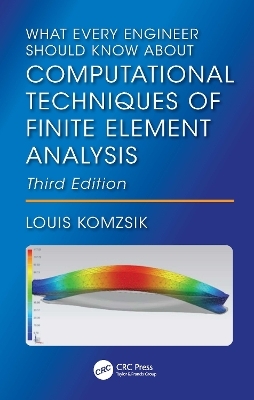
What Every Engineer Should Know About Computational Techniques of Finite Element Analysis
CRC Press (Verlag)
978-1-032-94837-9 (ISBN)
- Noch nicht erschienen (ca. April 2025)
- Versandkostenfrei innerhalb Deutschlands
- Auch auf Rechnung
- Verfügbarkeit in der Filiale vor Ort prüfen
- Artikel merken
This book is a concise, self-contained treatment of the finite element method and all the computational techniques needed for its efficient use and practical implementation. The book describes the process of transforming the physical problem into a mathematical model, the reduction of the mathematical model to numerically solvable computational form, and many practical engineering analysis solution techniques applied in various industries.
The first edition of this book was published in 2004, two decades ago. Since then, finite element analysis (FEA) has become a fundamental component of product development software tools (CAD, CAE, CAM) used in many industrial fields of engineering, particularly in mechanical and aerospace engineering. It has also become a popular text in CSE (Computational Science in Engineering) and applied mathematics courses in academia, one of the reasons for the new edition.
Key Features:
Contains additional physics application areas of heat transfer, wave propagation and fluid dynamics.
Extension of structural optimization into the topology optimization, an advancing engineering approach.
Provides a complete numerical example of a simple structure to aid the teaching of the method from the book.
Dr. Louis Komzsik is an engineer and mathematician, whose career spanned two continents and five decades. During his career he researched, implemented and applied finite element analysis techniques in the shipbuilding, aerospace, automotive and energy industries, as well as taught it at universities in California and Hungary. His experience is presented in this book hoping to aid a new generation of students and users of this technology.
Louis Komzsik is a graduate of the Technical University of Budapest with an engineering degree and the Eötvös University of Sciences in Budapest with a mathematics degree, both in Hungary. From 1974 through 2016 he worked in various industries in Europe and in the United States, in finite element analysis of ships, airplanes, automobiles, satellites and windmills. His work on numerical computational techniques for industrial finite element analysis has been captured in the NASTRAN Numerical methods handbook. He pioneered the introduction of several numerical techniques that became de-facto industrial standards; and his book about one of those topics, titled The Lanczos method, has also been published in Chinese, Japanese and Hungarian. He also worked on the topic of rotor dynamics and on the mathematical solution of structural topology optimization. He is the author of several technical books in 2nd or 3rd editions. His Approximation Techniques for Engineers, 2nd ed. (2016), Applied Calculus of Variations for Engineers, 3rd ed. (2018), and this Computational Techniques of Finite Element Analysis 3rd ed. (2024) are all used in industry and in academia worldwide. He is also the coauthor of Computational Techniques of Rotor Dynamics with the Finite Element Method originally published in 2012, and a 2nd edition is to be published later this year. After his retirement from industry, he lectured at the Mathematics Department of The University of California in Irvine from 2017 through 2020. Since 2021 he serves as Professor Emeritus of Applied Mathematics and teaches finite element analysis using this book as class text at Obuda University in Budapest, Hungary. In 2024 he received his gold diploma from the Technical University of Budapest celebrating his 50 years long engineering career.
1.Finite Element Analysis 2.Finite Element Model Generation 3.Modeling of Physical Phenomena 4.Constraints and Boundary Conditions 5.Singularity Detection of Finite Element Models 6.Coupling Physical Phenomena 7.Matrix Factorization and Linear Systems 8.Static Condensation 9.Real Spectral Computations 10.Complex Spectral Computations 11.Dynamic Reduction 12.Component Mode Synthesis 13.Modal Solution Technique 14.Transient Response Analysis 15.Frequency Domain Analysis 16.Nonlinear Analysis 17.Sensitivity and Optimization 18.Engineering Result Computations 19. Heat Transfer 20. Wave Propagation 21. Topology Optimization 22. Fluid dynamics
| Erscheint lt. Verlag | 15.4.2025 |
|---|---|
| Zusatzinfo | 20 Tables, black and white; 62 Line drawings, black and white; 30 Halftones, black and white; 92 Illustrations, black and white |
| Verlagsort | London |
| Sprache | englisch |
| Maße | 156 x 234 mm |
| Themenwelt | Mathematik / Informatik ► Mathematik ► Analysis |
| Technik ► Elektrotechnik / Energietechnik | |
| ISBN-10 | 1-032-94837-X / 103294837X |
| ISBN-13 | 978-1-032-94837-9 / 9781032948379 |
| Zustand | Neuware |
| Informationen gemäß Produktsicherheitsverordnung (GPSR) | |
| Haben Sie eine Frage zum Produkt? |
aus dem Bereich


